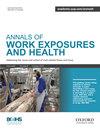71 利用工作领域分析探索工作环境管理的界限
IF 1.8
4区 医学
Q3 PUBLIC, ENVIRONMENTAL & OCCUPATIONAL HEALTH
引用次数: 0
摘要
背景 工作环境法规确定了雇主必须实现的具体目标。工作环境是一个多维概念,包括任务性质、物质和社会条件、工作场所特点和组织、工作时间安排、工人前景以及与工作相关的内在回报。工作领域分析是认知工作分析五个维度中的第一个维度,本研究通过工作领域分析探索工作环境管理的边界。方法 混合方法包括研究监管要求、有限的文献综述以及与作为主题专家的职业安全与健康执法官员的全面讨论,这些方法为分析中的抽象分解空间提供了信息。监管目的的可用性构成了工作环境管理的功能目的。确定的工作环境指标构成了价值和优先措施。与目的相关的功能由工作环境模型构建,并由主题专家提供相关的物理资源和资源所能提供的功能。结果 设计了工作环境管理的离子分解空间,显示了从资源到它们在系统中实现的目的之间的手段-目的联系。从抽象分解空间可以设计出支持决策的结果链模型。分析表明,可以通过不同的手段-目的途径来实现功能目的。此外,与目的相关的功能构造允许叠加先前检查报告中的执行命令,从而支持了构造的有效性。结论 本研究提供了工作环境管理的结构和内容,以及支持管理实践和加强实现合理工作环 境的决策模型。本文章由计算机程序翻译,如有差异,请以英文原文为准。
71 Exploring boundaries of work environment management using work domain analysis
Background Work environment regulations identify specific objectives that employers must fulfil. Work environment is a multidimensional concept encompassing nature of tasks, physical and social conditions, workplace characteristics and organisation, work schedule, prospects to the workers, and the intrinsic rewards associated with the work. Through work domain analysis, the first of the five dimensions of cognitive work analysis, the study explored the boundaries of work environment management. Method Mixed method including looking at regulatory requirements, a limited literature review and comprehensive discourse with occupational safety and health enforcement officials as subject matter experts provided the information to populate the abstraction decomposition space in the analysis. Affordances of the regulation purposes formed the functional purposes of the work environment management. Work environment indicators identified formed the value and priorities measures. Purpose-related functions were constructed from a work environment model, with subject matter experts providing the relevant physical resources and the functions the resources afford. Results ion decomposition space for work environment management was designed showing means-ends links from resources to the purposes they fulfil in the system. From the abstraction decomposition space, it was possible to design results-chain models supporting decision-making. The analysis showed that the functional purposes can be fulfilled with different means-ends pathways. In addition, the purpose-related functions constructions allowed for superimposing of enforcement orders from earlier inspections reports, supporting the validity of the constructs. Conclusion The study provided structure and content of work environment management, and decision-making models supporting the management practices and strengthening attainment of justifiable work environment.
求助全文
通过发布文献求助,成功后即可免费获取论文全文。
去求助
来源期刊

Annals Of Work Exposures and Health
Medicine-Public Health, Environmental and Occupational Health
CiteScore
4.60
自引率
19.20%
发文量
79
期刊介绍:
About the Journal
Annals of Work Exposures and Health is dedicated to presenting advances in exposure science supporting the recognition, quantification, and control of exposures at work, and epidemiological studies on their effects on human health and well-being. A key question we apply to submission is, "Is this paper going to help readers better understand, quantify, and control conditions at work that adversely or positively affect health and well-being?"
We are interested in high quality scientific research addressing:
the quantification of work exposures, including chemical, biological, physical, biomechanical, and psychosocial, and the elements of work organization giving rise to such exposures;
the relationship between these exposures and the acute and chronic health consequences for those exposed and their families and communities;
populations at special risk of work-related exposures including women, under-represented minorities, immigrants, and other vulnerable groups such as temporary, contingent and informal sector workers;
the effectiveness of interventions addressing exposure and risk including production technologies, work process engineering, and personal protective systems;
policies and management approaches to reduce risk and improve health and well-being among workers, their families or communities;
methodologies and mechanisms that underlie the quantification and/or control of exposure and risk.
There is heavy pressure on space in the journal, and the above interests mean that we do not usually publish papers that simply report local conditions without generalizable results. We are also unlikely to publish reports on human health and well-being without information on the work exposure characteristics giving rise to the effects. We particularly welcome contributions from scientists based in, or addressing conditions in, developing economies that fall within the above scope.
 求助内容:
求助内容: 应助结果提醒方式:
应助结果提醒方式:


